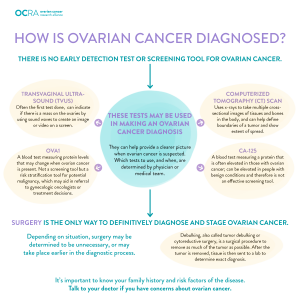
There are several types of ovarian cancer, and while they may have different origins, treatments, and prognosis, they all affect the ovaries and can be diagnosed with similar tests and procedures.
Before going down the path of diagnosis, it’s important to understand that symptoms are not always present with ovarian cancer. A good baseline is to understand and discuss family history and risk factors with a physician. If symptoms are present, the most common include bloating, difficulty eating or feeling full quickly, pelvic or abdominal pain, and/or urinary frequency lasting for more than two weeks. Learn more about ovarian cancer symptoms and detection.
There are common misconceptions about what routine procedures detect ovarian cancer. For starters, while annual check ups and pelvic exams are a good check for a general baseline of reproductive health, it should be noted that ovarian tumors are usually too small for this to be a method of detection.
Along the same lines, ovarian cancer cannot be diagnosed through a Pap smear. A Pap smear, common in an annual check up, only screens for cervical cancer.
To check for ovarian cancer, a physician may order the following imaging tests such as ultrasounds or blood work to gain insights as to what may be causing the symptoms.
Imaging Tests
Computerized tomography (CT) Scan
CT scans employ x-rays to take multiple cross-sectional images of the tissues and bones in the body. Doctors can analyze the images or use software to make a three-dimensional model of the internal organs. If present, a CT scan helps define the boundaries of a cancerous tumor and show the extent of tumor spread, helping a doctor determine where to operate.
Transvaginal ultrasound (TVUS)
A transvaginal ultrasound uses sound waves to create an image or video on a screen. It’s often the first test done and can indicate if there is a mass on the ovaries, and if that mass is solid, showing a tumor, or fluid-filled, indicating a cyst. A TVUS can also be used to get a better look at the ovary, to see if anything could potentially be a concern.
Surgical Procedures
Laparoscopy or Laparotomy
In a laparoscopy or laparotomy, a physician can examine the ovaries and other pelvic organs by using a thin tube that sends the images of the region to a video monitor. The major difference is that in the laparoscopy, the physician will use multiple, smaller incisions, while a laparotomy will use a singular, larger incision. Both procedures give a view that can better examine the cause of discomfort, how large tumors have grown and aids in planning surgeries or other treatments. In rare cases, during these procedures, the surgeon can also perform a biopsy.
Biopsy
The only way to definitively determine if a patient has ovarian cancer is through a biopsy. This is when tissues from a tumor are removed and tested in a lab. For an ovarian cancer diagnosis, in most cases, biopsies are guided by an ultrasound or CT scan, but in some situations where there is a concern that the biopsy could spread the cancer due to its advanced stage, or there’s another serious medical condition present, the biopsy can be done during a laparoscopy or laparotomy.
Blood Tests
OVA1
To aid in risk stratification, the process of determining what risk level someone has of developing ovarian cancer, OVA1 blood test has been approved by the Food and Drug Administration (FDA). The test measures the levels of five proteins in blood that change when ovarian cancer is present. However, this test has not been approved for use as an ovarian cancer screening tool, nor has it been proven to result in early detection or reduce the risk of death from this disease. Instead, it’s utilized to help determine if surgery should be done by a gynecologist or a gynecologic oncologist.
Inhibin B and Inhibin A
Specifically granulosa cell tumors are most often detected and/or monitored through Inhibin B and Inhibin A indicators. This is another test a physician may ask for to potentially diagnose ovarian cancer.
CA-125
Another blood test that can be ordered is for CA-125, which is a protein in the blood that is often elevated in women with ovarian cancer. It should be noted that CA-125 can be elevated in people with benign conditions, so the National Cancer Institute does not endorse using it as an ovarian cancer screening tool for women who are at ordinary risk of developing ovarian cancer.
Read more information on the CA-125 blood test here.
Once diagnosed with ovarian cancer, there are more tests and procedures to confirm the stage of the diagnosis and direct health care professionals to the best course of treatment. As with all cancers, early detection goes a long way, so it is critical patients have annual check ins with their gynecologist and open conversations about family health histories to see if there is an increased risk of the disease.


